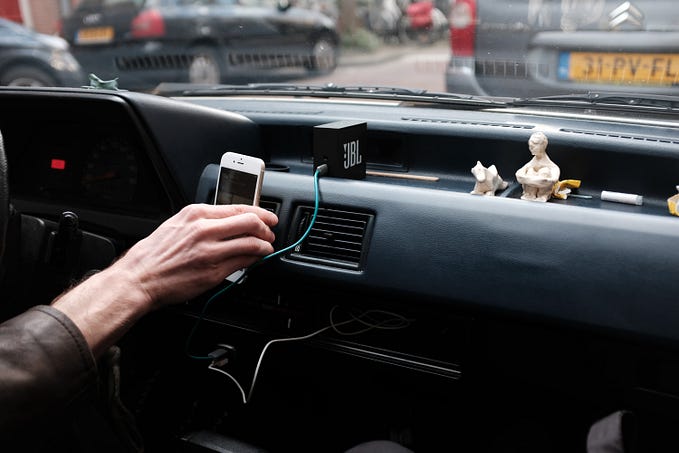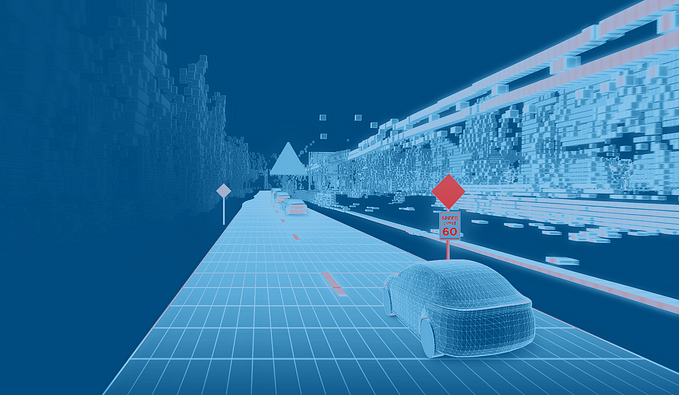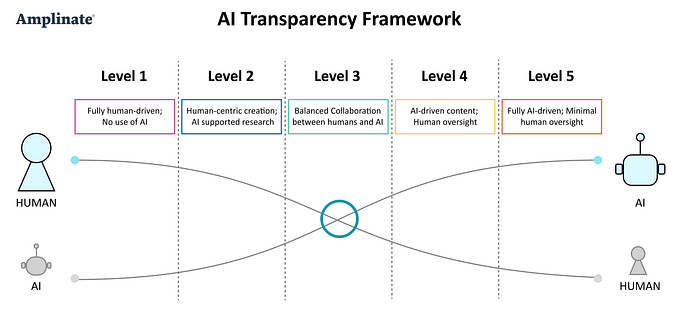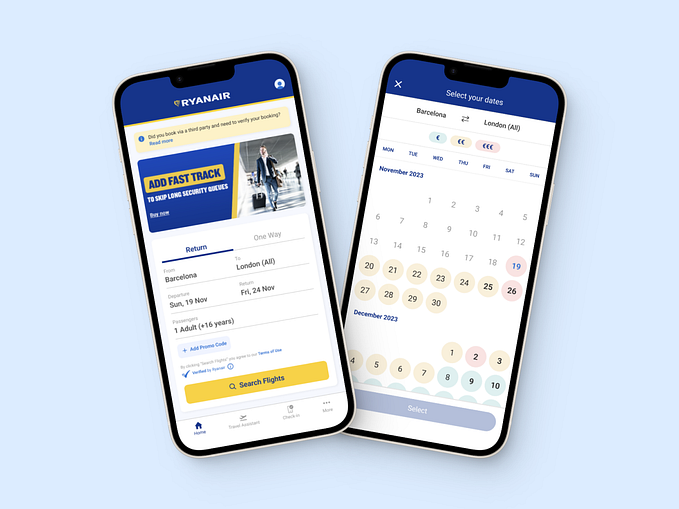Why UX is booming in the automotive industry
Part 3: The disruption of mobility
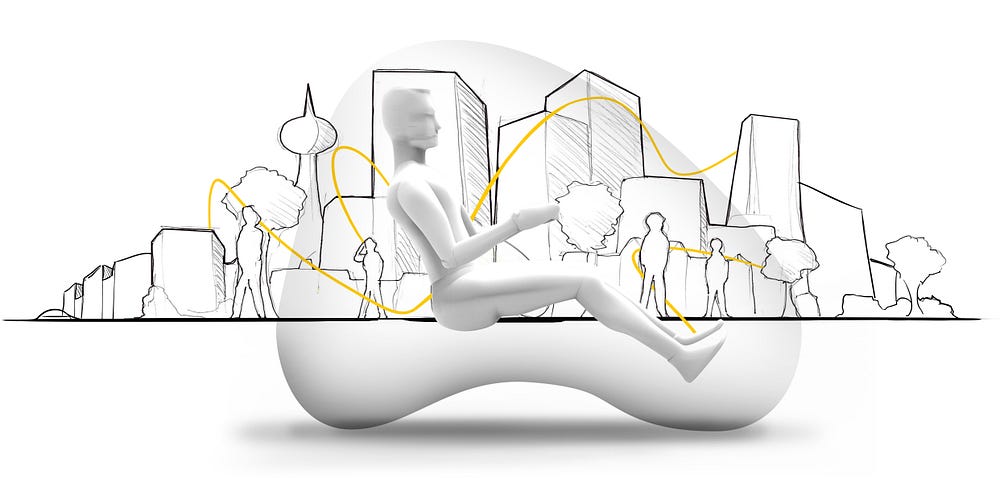
This is the third and last part of my series on why UX is booming in the field of automotive. A year ago I wrote about the UX when we are driving (part 1) or partially driving (part 2). As promised (sorry for the wait!), this time I will write about why UX is even more important for when we will not be driving any longer.
Still a steering wheel?
Often the levels of autonomy by the SAE are being used to describe the different flavours of autonomous driving. At level 0 the driver is responsible for all the driving, at level 5 the car is responsible. For all the levels in between the responsibility is shared, sort of… The levels are actually quite complex and not even that clear to experts, let alone customers.
So, let’s make things very easy. Does the car have a steering wheel? Then the driver has to be able to drive. Is there no steering wheel? Then there is no driver to be responsible. Simple, right? When focussing on the user experience, this simplification is far more relevant than the SAE levels.
For most autonomous cars that we will see the coming years, the driver still has to drive. Maybe it’s possible to read a book behind the wheel during a boring traffic jam, or a certain stretch of highway. But when things go unexpectedly wrong, the driver will need to be able to grab the steering wheel, rather quickly…
Doesn’t sound so safe, does it? Well, I think by providing the user with the right information during the ride this so-called handover can become a lot safer. Data plays an important role here, data that we at TomTom are dealing with. We know for instance when a traffic jam is clearing up; a good time to start waking up the driver again. We also know where a lot of interactivity between cars can occur, based on map and traffic data. Think about busy junctions with a lot of entries and exits; a good time to let the driver put away that newspaper.

This first step towards autonomous driving will definitely have a major impact within the coming years by allowing longer trips, safer roads, less emissions and less congestion. But further down the road this technology, in combination with 3 other big trends in the automotive market, might completely disrupt mobility. So, let’s take a look at the bigger picture.
We will see cars no longer as cars — the hardware
Every car company is talking about the acronym CASE, and rightly so. These 4 trends might disrupt mobility as we know it. Let’s first talk about the car itself, the ‘hardware’.
E is for Electric
We’re moving from combustion engines towards electric engines. Automotive companies are investing big time in this technology. But besides being better for the environment, it has another cool advantage; the design of the car is way more flexible. Electric engine(s) can sit within the wheels, and batteries can go anywhere, in any shape. Obviously, it makes sense to put them as low as possible, as they’re quite heavy. Combine this with steer-by-wire, and you end up with a very basic ‘platform’ on which the designer can create the wildest ideas.
A is for Autonomous
I covered autonomous cars with a steering wheel. But when we get rid of that thing, we don’t have to sit behind a steering wheel anymore, or sit towards the driving direction, or actually sit at all! Car designers can go crazy now! The act of driving will not define the interior any longer, it will be defined by all kinds of other interactions we can think of. Relaxing, dining, working, gaming, resting, partying, you name it. And as active safety systems are becoming the default today, the transition that will allow us to safely remove the seatbelt is inevitable. I think that when the design of cars will change this drastically, we will no longer see them as actual cars. This is an essential ingredient for the disruption.

Services instead of products — the software
People nowadays buy a car that fulfills all their needs. Holidays, families, groceries, commuting to work, it has to do it all. So, they most likely get a very big car, which they most of the time drive to work all alone, where it gets parked all day. Doesn’t this feel a bit outdated?
S is for sharing
Some time ago a different industry got disrupted, the music industry. Instead of owning records ourselves, we chose for on-demand music streaming. This creates a lot of freedom as we can now listen anything, anywhere, anytime. This will also happen to mobility, on-demand mobility.
On-demand mobility requires two technologies. First, you need an intelligent network that can distribute a vehicle fleet in a very efficient way. Data is key here, something that we at TomTom are highly aware of. Secondly, you need autonomous vehicles that can drive to the customer and set them off at their destination. So, the customer won’t waste time on getting their car and finding a parking spot. Kind of like the freedom of a ride with Uber, but with more privacy and lower cost. Yes cheaper, as these networks will be very efficient and do not require drivers. Probably even cheaper than owning your own car as you will have no costs like parking, maintenance, insurance etc.
“But I like driving!”, “I want to have my own car!”, “I live outside of the city, for me driving is freedom”. These are just some quotes I made up, but most likely people will react like this. So, let me make things clear. Cars that we know nowadays, that we can drive, that we love, will not disappear. Spotify didn’t eliminate vinyl stores, did they? And this shift towards on-demand will likely not happen in rural areas, because of coverage, just like Spotify requires internet coverage. Cars do convey a feeling of freedom, but not in congested cities. This is where on-demand mobility will be coming, it will be cheaper, more convenient and it will increase the quality of your time.

C is for connected
This brings me to the last letter, but the most important one for mobility companies that want to win the battle. When we stop seeing cars as cars, things we drive ourselves, we will instead see them as spaces that move us from A to B. Just like airplanes, trains, metro’s or even taxis. Do you ever choose an airplane company over the other, just because their airplanes looked cooler from the outside? Or based on the engine it has. Probably not. You most likely care more about how comfortable the chairs are, how much leg space you have, the quality of the meals and how friendly the staff is. What matters is the experience on the inside.
It’s that experience on which companies will differentiate themselves. Spotify does not just let me to listen to my favourite music, it learns my preference and suggests new music to me. I love Spotify because of the playlists they custom made for me, so I can explore new artists. Mobility companies should also think beyond getting the user from A to B, they should start thinking on how to create the best experience during your commute time.
In today’s economy it’s all about experiences; ‘experience economy’ is a huge trend. Just think about how companies could jump the wagon (pun intended). Maybe a business class experience with big super comfy chairs and big screens and speakers on which you can access all your favourite internet content. How about ordering breakfast and eating it in the same vehicle it got delivered in. That would save me a lot of time in the morning. How about Starbucks-on-wheels, enjoy your soy latte while going to work. Maybe you would like a meditation session in between stressful meetings with clients. Or have a pre-party on the way to the club. Drinks, music, lights, everything included.
Let me go back to the airplane example. You don’t choose an airplane company merely based on the experience during the flight, the whole customer journey is important. A frictionless, seamless user experience is what people want. Let me give another example with Spotify (it’s just so similar!). The song I’m listening to on my phone continues playing on my home speakers when I enter my house. That should also happen when I enter the vehicle I ordered. A seamless eco-system. With this idea I graduated 5 years ago at Daimler. Every shared car you would enter would become your car, the smart ‘foryou’.
I personally think the ‘assistant’ is going to be very important here, as it allows ambient computing. Yes, I’m talking about Siri, Alexa, Google Assistant and the likes. The assistant is the interface or operating system of the future. It will let users access their online services in a very natural way. Every computer becomes an interface, through which you can talk to your familiar assistant. So, you already know how to interact with it and the assistant knows you too.
But the cool thing is to imagine beyond current possibilities. The windows of the car could use augmented reality to change the perception of the environment. How about pointing to a building and ask your assistant what it is. Or how high it is. Maybe you are subscribed to an information feed to shows you the newest hipster restaurants in town. Maybe play interactive games with the environment. So, instead of looking down to our phones or paying attention to traffic when driving, we can actually enrich our connection with the physical environment. And digital maps serve as a great foundation for this.

City-centered design
Throughout the article I constantly made the comparison with Spotify. There is one more similarity and it is a concerning one. On-demand streaming services have changed our consumption patterns. We listen more often to music. Will we also start to commute more?
“But when it comes to autonomous vehicles, the most important question is not what they will be like on the inside. It’s what changes they will enable in the world around them.” — John Zimmer
Surely providers of mobility would like their customers to consume as much as possible. But their services don’t use the free world wide web as a network, the city infrastructure is being used as the ‘network’. So, you have to start collaborating with city municipalities. Something we at TomTom, are already doing in order to reduce congestion. Data again is key here, think about dynamic pricing to prevent congestion. Maybe your autonomous vehicle will take a 2 min longer route, but saves you a bit of money.
So, we should not only focus on the individual user experience. We should start to think how we can make cities better. How can we make more efficient use of our shared city space? Let’s aim for less parking places and less congestion. But also think about how vehicles will communicate with pedestrians, cyclists and other road users. Let’s design holistically.

UX is booming
Sitting behind the steering wheel in our big cars in congested cities is out-dated and unsustainable. Urban mobility will become an on-demand service allowing you to get a vehicle anywhere & anytime, creating an amazing freedom for the end user.
The whole user journey becomes relevant for us designers to think of. Getting in a vehicle should become a seamless experience. Mobility providers will need to think of ways to enrich the time of their customers during the commute in order to stay relevant. Tech will play a vital role here. Especially digital assistants, as they will make every shared vehicle feel familiar to the end user. That’s why UX is booming in the automotive industry.
The scarce resource in the 21st century will not be technology. It will be attention. — Mark Weiser
I’m Paul, a UX designer with a passion for mobility. I’m currently working on exciting things for the automotive market @ TomTom. Check out more on the smart foryou here. Have a question or want to share your thoughts? Feel free to reach out to me at paul.schouten@tomtom.com



